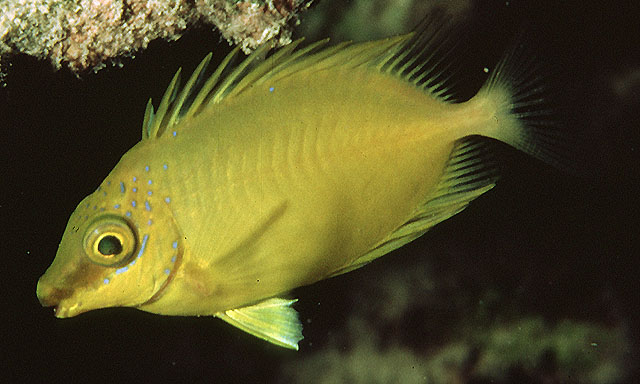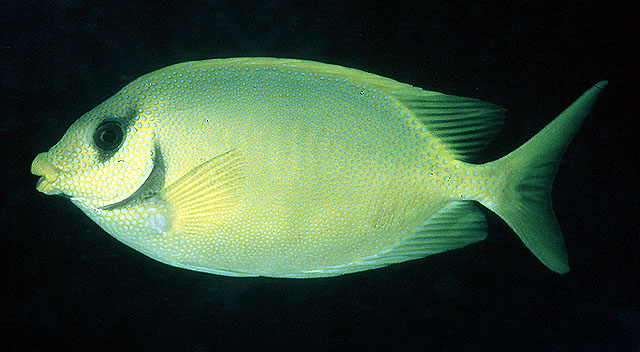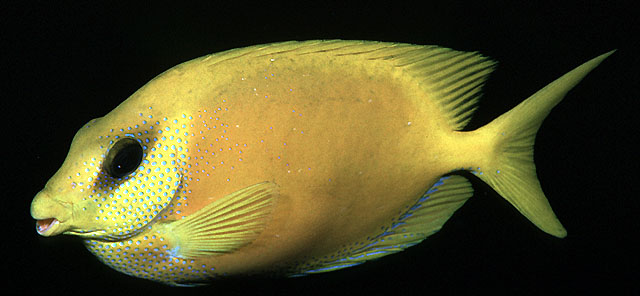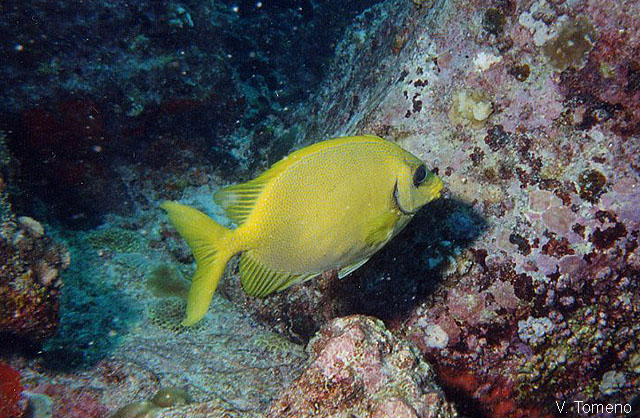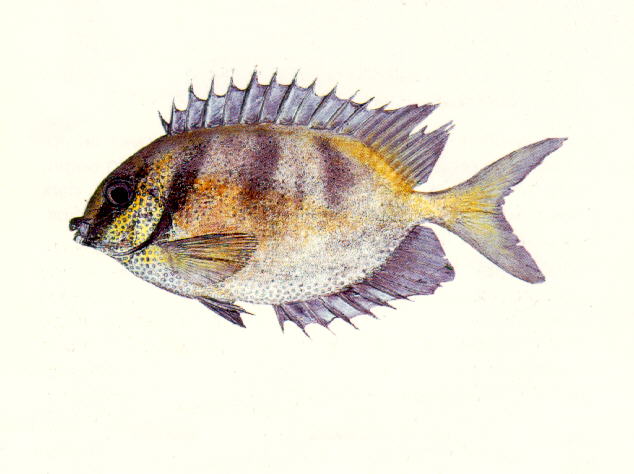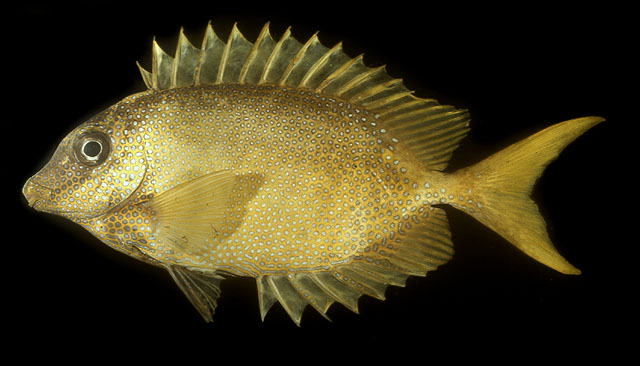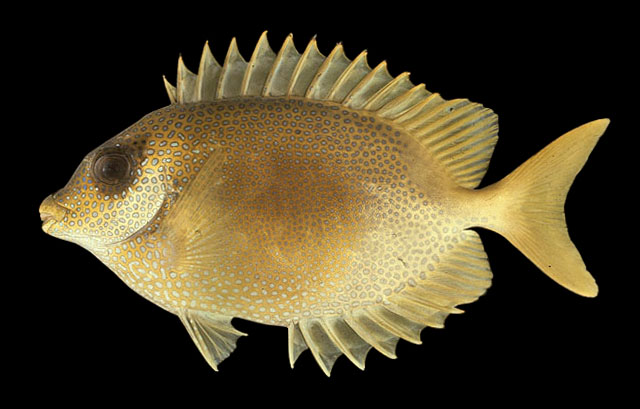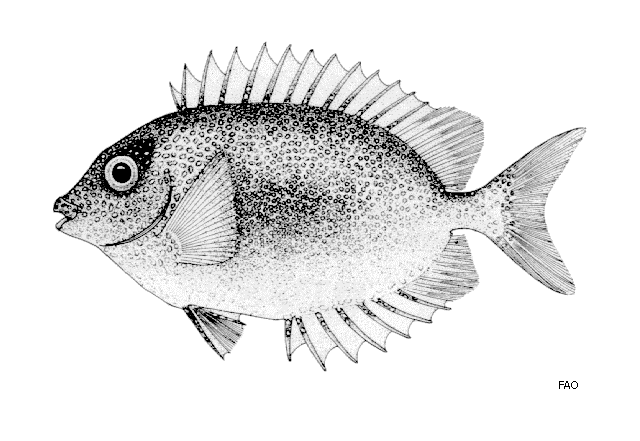Siganus
corallinus
(Valenciennes,
1835)
Blue-spotted spinefoot
View all media / Upload your photos and videos
Expand all
Classification / Names
Teleostei (teleosts) > Acanthuriformes (Surgeonfishes) >
Siganidae (Rabbitfishes)
Etymology: Siganus: Latin, siganus = a fish, rabbit fish; by the similarity of the nose (Ref. 45335).
More on author:
Valenciennes.
Environment / milieu / depth range / climate zone / distribution range
Distribution
Indo-West Pacific: Aldabra Islands, Seychelles, Maldives, Andaman Sea, Thailand, Indonesia, Peninsular Malaysia, Sabah, Singapore, Viet Nam, Philippines, Ryukyu Islands, Ogasawara Islands, Palau, ?Kiribati, Papua New Guinea, Solomon Islands, Australia, Vanuatu, and New Caledonia. Replaced by Siganus trispilos in northwest Australia (Ref. 37816).
Maps

Siganus corallinus / Native range
AquaMaps Data sources:
GBIF
OBIS
This map was computer-generated and has not yet been reviewed.

Siganus corallinus / Suitable habitat
AquaMaps Data sources:
GBIF
OBIS
This map was computer-generated and has not yet been reviewed.

Siganus corallinus / Point map
AquaMaps Data sources:
GBIF
OBIS
This map was computer-generated and has not yet been reviewed.

Siganus corallinus / Year 2050
AquaMaps Data sources:
GBIF
OBIS
This map was computer-generated and has not yet been reviewed.
Size / Weight / Age
Short description
Dorsal spines (total): 13; Dorsal soft rays (total): 10; Anal spines: 7; Anal soft rays: 9; Vertebrae: 13. Head, body and fins orange-yellow; pale blue ocelli with darker blue margins on head, thorax and sides; spots about pinhead size, larger and more crowded on head, sometimes smaller on sides; ocelli may extend onto bases of dorsal and anal fins, and on bases of outer rays of caudal fin. Very small juveniles (up to 50 mm SL) may have vertical blue lines on side, fragmenting into the ocelli with increase in size. Orbit with a diffused-edged dark, triangular smudge; orange-brown iris Fin spines stout, pungent and venomous. Midline of thorax and ridges fully scaled.
Biology
Main reference
Woodland, D.J. 1990 Revision of the fish family Siganidae with descriptions of two new species and comments on distribution and biology. Indo-Pac. Fish. (19):136 p. (Ref. 1419)
IUCN Red List Status (Ref. 125652)
Least Concern (LC); date assessed: March 10 2015
CITES (Ref. 131153)
Not Evaluated
CMS (Ref. 116361)
Not Evaluated
Threat to humans
Venomous (Ref. 4537)
More information
- Countries
- FAO areas
- Ecosystems
- Occurrences
- Introductions
- Stocks
- Ecology
- Diet
- Food items
- Food consumption
- Ration
- Common names
- Synonyms
- Metabolism
- Predators
- Ecotoxicology
- Reproduction
- Maturity
- Spawning
- Spawning aggregation
- Fecundity
- Eggs
- Egg development
- Age/Size
- Growth
- Length-weight
- Length-length
- Length-frequencies
- Morphometrics
- Morphology
- Larvae
- Larval dynamics
- Recruitment
- Abundance
- References
- Aquaculture
- Aquaculture profile
- Strains
- Genetics
- Allele frequencies
- Heritability
- Diseases
- Processing
- Mass conversion
- Vision
- Pictures
- Stamps, Coins Misc.
- Sounds
- Ciguatera
- Speed
- Swim. type
- Gill area
- Otoliths
- Brains
Estimates based on models
Preferred temperature (Ref. 123201): 24.7 - 29, mean 28.1 °C (based on 1288 cells).
Phylogenetic diversity index (Ref. 82804): PD50 = 0.5 [Uniqueness, from 0.5 = low to 2.0 = high].
Bayesian length-weight: a=0.01072 (0.00593 - 0.01935), b=3.17 (3.02 - 3.32), in cm total length, based on LWR estimates for this species & Genus-body shape (Ref. 93245).
Trophic level (Ref. 69278): 2.0 ±0.0 se; Based on diet studies.
Resilience (Ref. 120179): High, minimum population doubling time less than 15 months (Preliminary K or Fecundity.).
Fishing vulnerability (Ref. 59153): Low to moderate vulnerability (33 of 100).
Price category (Ref. 80766): High; Questionable: based on ex-vessel price for species in this genus.
Nutrients (Ref. 124155): Calcium = 34.9 [17.2, 80.0] mg/100g; Iron = 0.648 [0.306, 1.487] mg/100g; Protein = 18.5 [17.0, 20.0] %; Omega3 = 0.1 [0.1, 0.2] g/100g; Selenium = 21.7 [8.7, 54.3] μg/100g; VitaminA = 32.8 [7.7, 133.2] μg/100g; Zinc = 1.33 [0.52, 2.82] mg/100g (wet weight);

